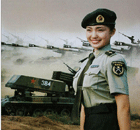Energy
Slowing growth does not deter wind power's long-term promise
(China Daily)
Updated: 2009-11-16 08:00
Equipment manufacturing
At present, the domestic wind power equipment manufacturing industry has formed a production system covering blades, gear boxes, generators, towers and other main parts. Among these, blade and turbine manufacturing is experiencing overcapacity, while there is still a shortage in production for the bearer.
Considering the supply and demand for wind power equipment, the amount of blades and turbines currently under construction exceeds the estimated market demand for the next two years, which leads to overcapacity.
According to the wind power development plan of the Chinese government, an additional 10 million kW and 12 million kW capacity will be introduced in 2009 and 2010, respectively.
However, the major domestic turbine producers plan to expand their effective capacity to around 11 million kW and 19 million kW in 2009 and 2010, respectively.
The top three enterprises in wind power -- Sinovel Wind, Goldwind Science & Technology Co and Dongfang Electric Corp -- are estimated to own a combined capacity of 7.6 million kW in 2009, 11 million kW in 2010 and 15 million kW in 2011.
Besides the three giants, there are about 60 to 70 medium-sized wind power turbine manufacturers, which started their research and development (R&D) around 2006 and 2007. They are expected to proceed to the small-batch production stage in 2009 and 2010.
These manufacturers will have to face the fierce competition of market share in the next few years when overcapacity brings down price and profit margins. However, the current gross profit margin is barely satisfactory.
Goldwind possessed a gross margin of 18 percent to 28 percent in 2008, while the number for Dongfang Electric was just around 11 percent.
The number of blade manufacturers increased rapidly in recent years. In the meantime, the wind turbine producers tended to produce their own blades because it accounts for a large portion of the whole value of a machine. This led to fast growth in capacity, which exceeds the future market demand, said Frost & Sullivan.
However, there are investment opportunities in the manufacture of bearings, where the gap between supply and demand still exists.
There are limited companies that are capable of producing yaw bearings and pitch system bearings, while the main bearings of wind power generators rely almost entirely on imports. Judging from the present situation, the market for bearings will not reach a balance in a short time. As a result, the high profit margin of bearings is estimated to remain in place for a relatively long time.
Related industries
According to a Frost & Sullivan analysis, investment opportunities also exist in the energy storage battery market, among other related markets.
Energy storage batteries can smooth the impact on the grid caused by the intermittence of wind power to ensure the continuity and stability of power transmission.
When the installed capacity of large grid-connected wind power farms exceeds 10 percent of the total capacity of the grid system, energy storage batteries will be needed to stabilize the voltage.
|
|||
Only if the peak load regulation margin of the local grid exceeds WPPL will the power generated by wind be fully absorbed. As a result, the absorptive capacity of wind power differs in different areas with diverse power structures.
According to the construction plans of wind power farms, Inner Mongolia, Gansu province and northeastern China will have a WPPL of more than 10 percent in 2010, which will exceed the largest capacity that can be absorbed by the local grids. Besides, harmonic pollution and a decline in power quality will be the byproducts of the grid-connection of wind power.













